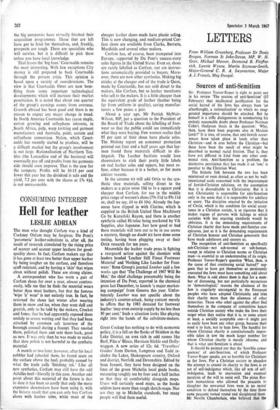Hell for leather
CONSUMING INTEREST LESLIE ADRIAN
The man who thought Corfam was a kind of Cockney Oxfam may be forgiven. Du Pont's 'poromeric' leather-substitute is, after all, the result of research stimulated by the rising price of scarcer and scarcer upper leathers for good- quality shoes. In fact, Corfam makers say that it has gone at least two better than upper leather by being tougher on the surface, and therefore scuff-resistant, and by having a 'skin' that wipes clean without polish. These are strong claims.
A correspondent who has worn a pair of Corfam shoes for over a year, almost continu- ously, tells me that he finds the material wears better than most leathers, but that the famous 'wipe 'n' wear' is not entirely true. In fact, he returned the shoes last winter after wearing them in snow and ice, when they went dull and greyish, only to be told by the makers, Crocket and Jones, that he had apparently exposed them unduly to severe wetting and that they had been attacked by common salt (courtesy of the borough council during a freeze). They resoled them, polished them and sent them back, good as new. It was only then he was made to realise that shoe polish is not harmful to the synthetic material.
A month or two later, however, after his local cobbler had reheeled them, he found scars on the surface above the heel, probably caused by what the trade calls 'finishing ink.' Like all new synthetics, Corfam may still have the odd Achilles heel—literally in this case. Another odd point about this material of the future is that to date it has been so costly that only the more expensive shoemakers have been using it, with the bizarre result that you can only buy Corfam shoes with leather soles, while most of the cheaper leather shoes made have plastic soling. This is now changing, and medium-priced Cor- fam shoes are available from Clarks, Barratts, Manfields and several other makers.
Corfam has, of course, been trumpeted into Europe, supported by Du Pont's success-story sales figures in the United States. Even so, shoes are rarely labelled as Corfam, nor are instruc- tions automatically provided to buyers. More- over, there are now other synthetics. Making big strides at the cheaper end of the trade is Quox, made by Courtaulds, but not sold direct to the makers, like Corfam, but to leather merchants who sell to the makers. It is a little cheaper than the equivalent grade of leather (leather being far from uniform in quality), saving manufac- turers a few pence a pair.
About a year ago, Mr Patrick McNair- Wilson, MP, put a question to the President of the Board of Trade about the labelling of foot- wear so that the public could see immediately what they were buying. Few women realise that 95 per cent of their shoes have plastic soles. The Molony report on consumer protection pointed out four and a half years ago that lay- men found these materials difficult to dis- tinguish. The Leather Institute would love shoemakers to stick their pretty little labels on real leather soles and uppers, but most re- fuse, either because it is a bother, or for more sinister reasons.
In the autumn ict will add Ortix to the syn- thetic shoe materials, selling direct to the makers at a price some 10d to Is a square yard cheaper than Corfam, for use in the middle price range of women's shoes (79s I Id to 89s lld or, shall we say, £4 to £4 10s). Already the Jap- anese have slipped in with Clarino, which is supplied to the British United Shoe Machinery Co by Kurashiki Rayon, and there is another synthetic called Hi-telac being marketed by Vik Supplies, also Japanese. Just how good or bad these materials will turn out to be in use seems a mystery, though no doubt la have done some testing, having been plugging away at their Ortix research for ten years.
Meanwhile the leather trade press is fighting a rearguard action against the chemists with leaders headed 'Leather Still Finest Footwear Material' and 'Nothing Like Leather for Foot- wear.' Berm Group's journal Leather said a few weeks ago that 'The Challenge of 1967 Will Be Met,' the chief challenge presumably being the intention of Du Pont, reported in the chemical press last December, to launch 'a major market- ing campaign' from Geneva this year. Unfor- tunately Leather was not specific about the industry's counter-attack, being content merely to affirm that by 1983 demand for footwear leather 'may even outstrip supply by no less than 30 per cent.' Such a situation looks like playing right into the hands of the substitute-makers.
Great Cockup has nothing to do with economic policy, it is a fell on the flanks of Skiddaw in the Lake District, an area rich in odd names like Barf, Pike o' Blisco, Harrison Stickle and Dolly- waggon. A new series of 12s. 6d. 'Travellers' Guides' from Darton, Longman and Todd in- cludes the Lakes, Shakespeare country, Oxford and district, Norfolk and Devonshire. Edited by Sean Jennett, they have been designed on the lines of the green Michelin local guide books, measuring roughly ten by four and a half inches so that they sit comfortably alongside maps. Users will certainly need maps, as the books seldom have more than rough sketch-maps. Nor are they up to Michelin standards, but many people will find them useful.


































 Previous page
Previous page